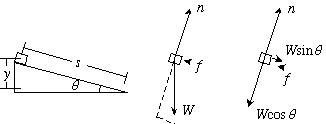
Updated 06/21/09
Text, p. 124
The Work-Energy Theorem
is: Wnet = Kf - Ki = DKE,
where Wnet = FnetDx.
For conservative forces, the
law of conservation of energy has the form: (KEf - KEi)
+ (PEf - PEi)
= 0
where PE refers to any form of potential energy. In
particular,
GRAVITATIONAL POTENTIAL ENERGY is
expressed as PEgrav = mgh, where h is
the vertical distance
of the center
of mass from some arbitrarily chosen zero energy
reference level.
ELASTIC POTENTIAL ENERGY is
expressed
as PEs = (1/2)kx2, where x is the
distance the spring is stretched or
compressed and k is the elastic
constant
or stiffness constant, defined by Hooke’s law: F = -kx.
Gravitational and elastic forces are conservative forces; they depend only on position change.
For nonconservative forces, such as friction, a "work-like" quantity Wnc is defined to give a more general expression for energy conservation:
Wnc = (KEf + PEf) - (KEi + PEi) = DKE + DPE
To find Wnc for friction forces, use
Wnc = -fs,
where f is the magnitude of the friction force (f = µn) and s is the displacement of the body involved in the frictional interaction (e.g., a block slides a distance s while being slowed by friction). When a body is in motion and friction forces are involved, use the coefficient of kinetic friction, µk.
For "block on an incline" types of problems, a free body diagram illustrates the forces involved.

The friction force is:
f = µn = µWcosq = µmgcosq
If there is friction and the block starts from rest and PE = 0 at the bottom, conservation of energy gives us:
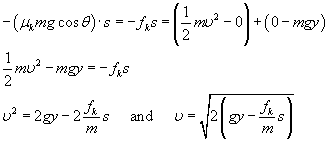
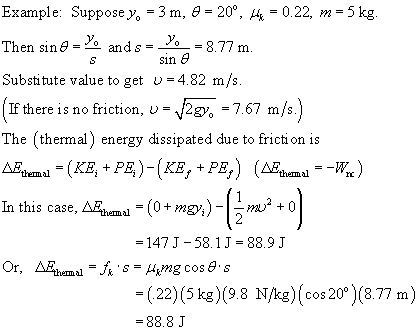
Now try this. A frictionless
roller
coaster has the dimensions shown here. The car has a velocity of
magnitude
u1
at the top of a hill, u2
at ground level, and dips to a point 4 m below ground level where its
velocity
has magnitude u3.
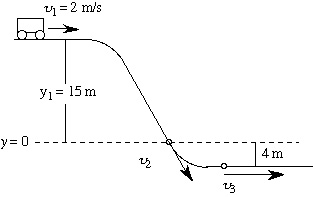
Use conservation of energy to find u2 and u3.
A spring-mass problem. A block of mass .005 kg is at rest on a spring that has been compressed a distance .04 m from its equilibrium position and locked in place. The spring lock is released and the block accelerates upward. The elastic constant of the spring is 75 N/m.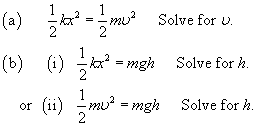
Roller coaster problem: u2 = 17.3 m/s, u3 = 19.4 m/s.
Spring-mass problem: (a) 4.9 m/s (b) 1.22 m
Return